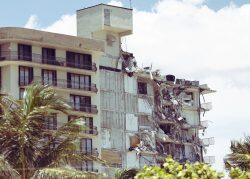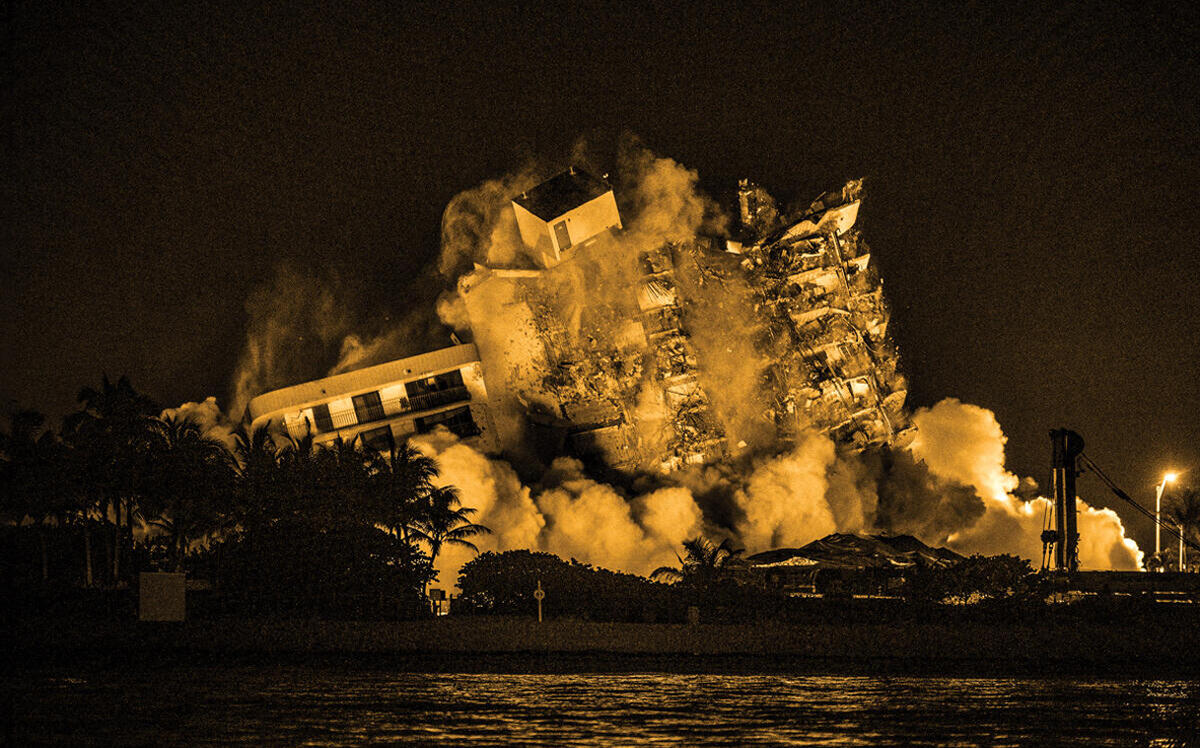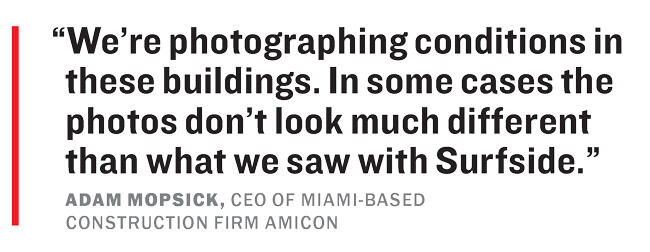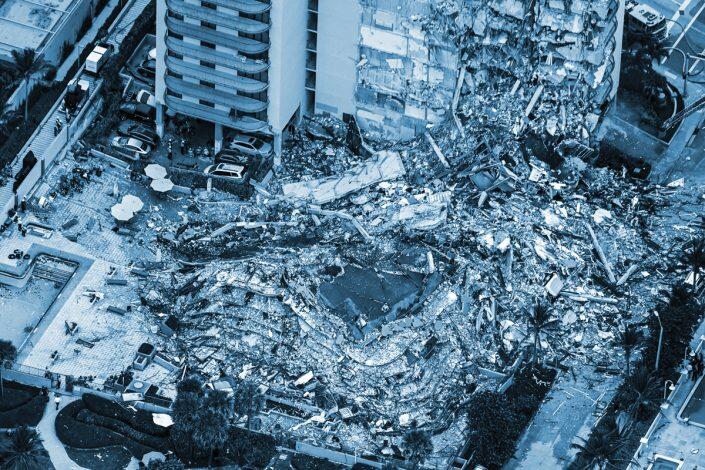 Days before condo fell, urgent requests faced bureaucratic replies
Days before condo fell, urgent requests faced bureaucratic replies
Trending
Surfside condo collapse prompts industry changes
Tragedy in South Florida sends aftershocks rippling across the country

Raysa Rodriguez, 59, described the moment she was awakened by the collapsing northeast portion of her Surfside condo building, home to more than 50 units.
The tower “swayed like a sheet of paper,” Rodriguez said, according to a lawsuit filed on her behalf. It was 1:30 a.m. on June 24, and she fled. After making it to an outdoor stairwell, she was faced with the devastation that had been Champlain Towers South.
“The beachside of Champlain had collapsed, pancaked,” she recounted in the complaint. “I screamed in horror.”
At least 90 people died in the disaster, according to the latest count, with dozens of others still unaccounted for. The collapse of the tower, where a 2018 inspection identified design and structural flaws, has sent aftershocks reverberating across the country as residents of buildings from Miami Beach to California are alerting engineers and inspectors to cracked concrete, rusty rebar and water leaks.
“We’re photographing conditions in these buildings,” said Adam Mopsick, CEO of Miami-based construction firm Amicon, which manages projects for condo associations. “In some cases the photos don’t look much different than what we saw with Surfside.”
The search and rescue operation became a search and recovery nearly two weeks after the collapse when officials acknowledged that survivors would not be found.
Mopsick was on the phone with clients all weekend after the oceanfront side of the Surfside tower crumbled into the pool deck and underground garage. He said his firm is getting so many calls from condo associations that he is hiring engineers to deal with the increased demand.
In North Miami Beach, a 156-unit condo building fronting a canal was deemed unsafe by the city and evacuated roughly a week after the collapse.
Across the country in Marina del Rey, California, residents of a 600-unit waterfront condo just north of Los Angeles International Airport feared they were next. Like the Champlain condo owners, they had deferred maintenance at the development, the Los Angeles Times reported. Inspectors determined that the structure was not in imminent danger of collapsing.
With more inspections underway and questions about the official cause of the Surfside collapse, the families of the victims are calling for changes to building codes and questioning the level of responsibility volunteer condo associations bear regarding safety issues. Insurers are being more demanding of proof of recertifications, and government officials are calling for investigations.
Mass tragedies have resulted in increased regulation in the past. New York’s deadly Triangle Shirtwaist Factory fire in 1911 led to the creation of a number of critical safety standards. And more recently, Hurricane Andrew, which destroyed more than 63,000 homes when it hit in 1992, changed Florida’s building codes. They are now considered some of the strongest in the country.
“Some of these things are preventable,” said Javier Lopez, managing partner of the Florida-based law firm Kozyak Tropin & Throckmorton. “I think we can all agree that buildings don’t just collapse. It doesn’t just happen.”
Lawsuits multiply
Rodriguez’s lawsuit is one of at least five that have been filed against the condo association in the days since the collapse. An independent receiver was appointed to help determine how to distribute the $48 million in insurance money and any other proceeds. The association board voted unanimously for an independent party to handle the lawsuits.
The complaints lay out a number of problems the building has had dating back to the late 1990s, including standing saltwater and concrete falling in the underground garage.

Champlain Towers South was one of three Champlain buildings in close proximity, but not adjacent, to each other that were developed by a group led by the late Canadian developer Nathan Reiber, who had been charged with tax evasion in Canada before moving to South Florida, according to the Washington Post. He was accused of using campaign contributions to influence politicians to approve the project.
In 2018, the board hired engineer Frank Morabito to survey the building for its required 40-year structural and electrical recertification. Morabito’s findings were alarming. He pointed to issues with the 1979 building plans that were prepared by William M. Friedman & Associates Architects and Breiterman Jurado & Associates.
Among the problems: “abundant cracking and spalling,’’ in which fragments of concrete break off, as well as failed waterproofing below the pool deck that was causing “major structural damage” to the slab below the deck, entrance drive and planters. The pool deck was located above the garage.
Rodriguez, the resident who escaped, described how she and her neighbors attempted to get out though the pool deck, only to have to climb back up through the rubble and find another exit. “It was dark and I could hear water flooding into the garage. I knew being electrocuted was a possibility,” she said.
Morabito’s report found that the reinforced concrete slab was designed so that water would pool on it, wearing on the waterproofing, instead of draining off. He called the original design “a major error.”
Damage spreads
But nothing happened. Damage spread and worsened, and costs increased. The association had $800,000 in reserves, but millions of dollars worth of repairs to undergo. Special assessments — a dirty phrase for condo owners — were required. The charges, which are separate from monthly association dues, may not affect all unit owners, but all unit owners must pay them to cover repairs to a building or community.
Residents had also feared that construction of the adjacent Eighty Seven Park condo tower, which caused the Champlain Towers South to vibrate, had exacerbated problems, especially in the underground garage. The developer, led by David Martin’s Terra and Bizzi & Partners, offered the building $400,000 during construction amid complaints about falling debris, noise and more, according to the Washington Post.
The developer of Eighty Seven Park didn’t comment on the payment, but said in a statement: “We are confident that the construction of 87 Park did not cause or contribute to the collapse.’’
A former member of Champlain Towers South’s condo board, Max Friedman, told the New York Times that at the time of the 2018 report, “people were quitting, and there were new people, and there was all kinds of stuff that was going on that was not pleasant.”
In April of this year, the association finally began the more than $15 million repair project with the replacement of the roof. In a letter to unit owners that detailed the extensive project the building was about to undertake, association President Jean Wodnicki wrote that the damage had “gotten significantly worse since the initial inspection” by Morabito in 2018.
Wodnicki closed out the letter by acknowledging the infighting among board members and unit owners. “We have discussed, debated, and argued for years now,” she wrote. “And will continue to do so for years to come as different items come into play.”
Mopsick of Amicon said the calamity has “shined a light on the process of living in a condo building and what that means. It’s harder to get things done and approved.” Unit owners fight pricey assessments and increases in their monthly dues, while boards disagree on how to handle pressing issues.

Search and rescue personnel working onsite after the partial collapse of Champlain Towers South in Surfside
Lawyers and other experts have pointed to cracks in the system — the level of responsibility that associations have, potential conflicts of interest between engineers and contractors, and the 40-year recertification process itself.
“We’re already getting phone calls from condo associations and owners to see what their rights are to demand their buildings go through the recertification process prior to the 40-year recertification,” said Lopez.
Market shifts
Special assessments have prompted unit owners to list their condos for sale, passing the cost onto someone else. In rare cases, owners in older buildings will agree to sell to a developer who then terminates the condo and builds a new project.
Lopez said a friend sold his ninth-floor unit at Champlain Towers South days before the collapse for $710,000 as a result of the roughly $130,000 assessment. “Building has a special assessment in place for 180 months just approved,” the listing for the unit reads. The sale closed June 17, one week before the collapse, according to the Multiple Listing Service.
South Florida developer Rishi Kapoor said there is a “very real possibility of depreciation of older units over the next 12 months, especially if you have a building that hasn’t done its 40-year recertification yet.”
Kapoor said he’s had buyers ask who the contractors are on his projects, and friends and investors are questioning the safety of the buildings they live in. Brokers say buyers are putting deals on hold.
“Those questions that were brought up over the last week are not what you would consider the first questions that come up in a sales meeting,” Kapoor said. “The concerns are real. This is not because I’m a new-condo developer. This is basic human psychology. There is going to be fear associated with older buildings.”
Read more
 Days before condo fell, urgent requests faced bureaucratic replies
Days before condo fell, urgent requests faced bureaucratic replies
 Surfside condo “a time bomb:” Survivor’s lawsuit cites falling concrete, cracks and standing seawater in garage
Surfside condo “a time bomb:” Survivor’s lawsuit cites falling concrete, cracks and standing seawater in garage
Some industry professionals expect there will be a bigger premium on new construction than before. Lenders and insurers are expected to tighten restrictions on purchases in older buildings.
Broker Andres Asion said agents should be more transparent about whether a building is in the midst of a major special assessment or recertification.
He said buyers should “dig deeper. Don’t take somebody’s word for it. Ask the questions, and ask to get copies of the engineering reports.”
Still, the lasting impact on the market as a result of the collapse remains an open question.
“What I’ve learned through the financial crisis, through 9/11, through Superstorm Sandy, you don’t know what you don’t know while it’s happening,” said Jonathan Miller, real estate appraiser and author of Douglas Elliman’s market reports. “This is a horrific tragedy, and it puts everybody on notice to pay attention. I don’t think it has much to do with the trajectory of the market.”
A wake-up call
Many have pointed fingers at the board of the condo association, which waited more than two and a half years to act on the 2018 survey of the building. Residents had complained about issues at Champlain Towers South for years. But the problem in many associations is that some unit owners can’t afford major repairs.
“The biggest thing is money,” said Bruce Masia, Southeast regional vice president and partner at KW Property Management, which manages 90,000 units in Florida and the Bahamas. “That’s the problem with these buildings. People want to push it off.”
Some say that the government should require engineers in cases such as the 2018 Champlain Towers South report to immediately alert municipalities about safety concerns. But in Surfside, a town building official assured the association that it was in “very good shape.”
Otherwise, a lack of funds can drive the conversation.
“It’s not like you can just snap your fingers and have this done overnight. It takes a lot of planning, coordination, politics, financing,” said attorney Carolina Sznajderman Sheir of Eisinger Law, calling it a major dilemma for many communities. “They don’t want to pay special assessments. Many of them are on fixed incomes. It’s a huge outlay for many associations.”
Condo owners throughout South Florida may not have much of a choice moving forward. Insurers have already sent letters to owners of units 40 years and older in the region, demanding proof within a couple of months that properties are up to code or they will be at risk of their policies being canceled, according to the Miami Herald. Forty-year recertifications are only required in Miami-Dade and Broward counties. Since the collapse, Miami-Dade and municipalities within the county have been reviewing older multifamily buildings that have not yet gone through their recertification, resulting in the evacuation of the building in North Miami Beach.
A substantial number of the 50 percent of Floridians who live in properties with condo or homeowners’ associations could be affected as insurers try to mitigate their risks during an already risky time — hurricane season.
At Champlain Towers South, insurance coverage totaled at least $48 million, not including the insurance individual unit owners had. The property, whose remaining portion was recently demolished, will eventually be listed for sale, with the proceeds going toward the victims, though it’s unclear what would be built on the site.
“You have to hope that everybody uses this as a wake-up call,” Kapoor said. “How do we improve as a community to not lay waste to the people who have lost their lives?”
Lidia Dinkova contributed reporting.




